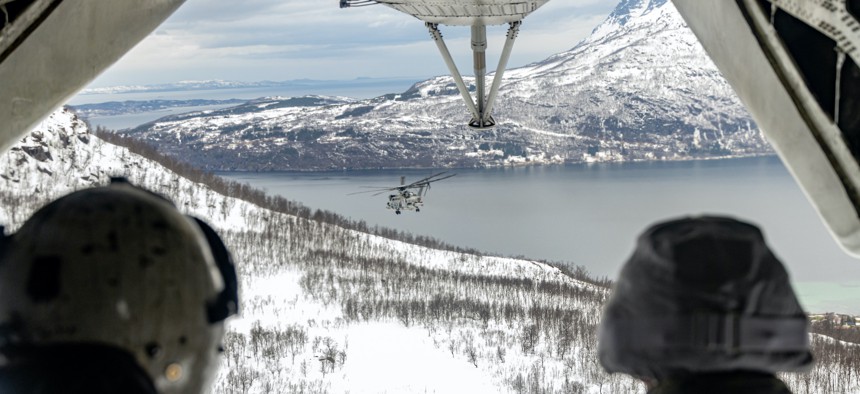
Marine Corps Sgt. Justin Gowan and a British Royal Marine Commando sit on the tail ramp of a CH-53E Super Stallion during Exercise Cold Response in Norway, March 17, 2022. U.S. Marine Corps / Chief Warrant Officer 2 Bryan Nygaard
Ukraine Gives Urgency to Giant NATO Cold-Weather Exercise
Russia is surely watching the 29-country wargame closely.
NATO’s massive Cold Response 2022 was supposed to distinguish itself in one way: it’s a massive—30,000-troop—cold-weather exercise involving nearly all of NATO’s member states. But since it began in Norway last week, Cold Response 2022 has also distinguished itself in two unpredicted ways: four U.S. Marines have lost their lives in an accident, and the exercise is taking place amid a brutal war in the neighborhood.
“We’ve been planning this exercise for a long time,” Lt. Gen. Yngve Odlo, the chief of the Norwegian Armed Forces’ operative headquarters, told me. “We wanted to host the exercise, so we invited the other countries and developed the scenario: reinforcement of Norway in a crisis situation, with activities in all domains—sea, land, air.” Indeed, Cold Response 2022 was conceived long before Russia invaded Ukraine, and was announced on June 21 last year. Twenty-seven NATO member states are participating, as are NATO partners Sweden and Finland, and the more than 30,000 people involved include some 14,000 ground troops, 8,000 sailors and navy troops, and 8,000 air force troops and staff officers. The exercise, which practices NATO’s ability to deploy tens of thousands of soldiers to the High North, also features some 220 aircraft and more than 50 vessels.
But the coincidence that Cold Response has ended up taking place alongside a war in Europe makes it unique in post-World War II history—and uniquely useful.
“All the countries have exercise objectives, but the goal is for us to cooperate smoothly together,” Odlo said. “And course the war in Ukraine is having an impact. We’re seeing that what we’re exercising matters. We’re experiencing that a neighbor has the desire to annex another country. But logistically, the war isn’t having an impact.”
A 30,000-military personnel exercise is sizeable to begin with. In recent NATO memory, only Trident Juncture 2018, which also took place in Norway, but in the summer, has involved more troops. When the 30,000 come from 29 countries, though, the task becomes infinitely more complex.
“Coordination is always the tricky part when you have many countries exercising together,” Odlo said. “Our job is to organize an exercise where we get maximum coordination using realistic scenarios. Yes, it’s complex—but the crisis in Ukraine has certainly increased NATO member states’ willingness to work together.”
Or put another way: the war in Ukraine has frightened NATO member states, and as a result at least 27 of them now realize that their armed forces need to exercise together, not just in table-top settings but out in the field, under realistic conditions.
That involves a certain amount of risk, particularly in wintry weather. On March 18, four Marines were killed when their MV-22 Osprey helicopter crashed flying in stormy weather off the coast of northern Norway. (The four were Capt. Matthew Tomkiewicz, Capt. Ross Reynolds, Gunnery Sgt. James Speedy, and Cpl. Jacob Moore, 24.)
“The deaths of the four Marines demonstrates the realism of what we’re doing,” Odlo said. “If we’re going to be effective in crises and wars, we have to exercise under realistic conditions. That includes bad weather. Of course we have many ways of minimizing the risk, but we can never eliminate it.”
Indeed, while the Russian military seems to have a high tolerance for the loss of troops’ lives, the Russian performance in Ukraine to date suggests that the Russian Armed Forces have not exercised enough under realistic conditions and using realistic scenarios.
“We picked up indications that some troops have actually suffered and taken out of the fight because of frostbite. So yes, they are having continued logistics and sustainment issues ... because the Ukrainians had done a good job frustrating their efforts to resupply,” a senior U.S. official told reporters this week.
It’s unclear exactly how many Russian soldiers—ranging from privates to generals—have died in the war, but on March 21 the Russian daily Komsomolskaya Pravda reported that the number had reached a staggering 9,861. (The article was quickly removed.)
Months ago, Odlo personally delivered—by video chat with his Russian counterpart—Norway’s invitation to Russia to participate as an observer. (The OSCE’s so-called Vienna Document encourages member states to invite military observers.) Russia declined.
But even distracted by their war in Ukraine, Russia’s armed forces are certain to be watching Cold Response 2022 closely. With their own operational challenges recently exposed, the Russians will no doubt be seeking insights into how NATO member states and partners handle coordination and interoperability.
Elisabeth Braw is a Senior Fellow at AEI, specializing in defense against gray-zone aggression. She previously directed the Modern Deterrence program at the Royal United Services Institute. She is the author of The Defender's Dilemma Identifying and Deterring Gray-Zone Aggression (AEI, 2021).




